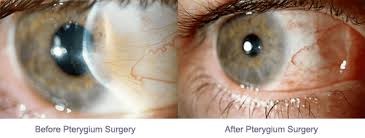It’s best to approach pterygium surgery with the goal of reducing the chances of recurrence at all costs. While most pterygia are asymptomatic and regarded as garden variety lesions, they become serious problems if they recur after removal. These cases most certainly warrant a subspecialist evaluation. In this article, I’ll discuss some surgical approaches to pterygium, with particular emphasis on recurrent pterygium.
There are many different ways to do a basic pterygium removal, and potentially hundreds of modifications of the surgical technique. The most common method of simple excision takes about five minutes but is associated with a much higher relative risk of the pterygium recurring. For this technique, you simply pry the scar tissue off the cornea and snip it off. It’s effective for about 90 percent of cases, but that means you can expect approximately 10 percent of cases to recur (often with a vengeance).
As a medical adjuvant to the simple snip excision, one might also consider the adjunctive use of antimetabolites such as mitomycin-C on the surgical site. This isn’t something that I usually do however, because mitomycin carries the risk of scleral melting. If you’re concerned enough to pour chemotherapy on the surface of the eye to prevent the pterygium from coming back, then, rather than using the mitomycin technique, the optimal thing to do would be to try the PERFECT technique.

Medications :
- If you have any discomfort after surgery, you may take Tylenol or Ibuprofen as directed. Prescription medication is available if needed for comfort (see reverse side of this form for instructions).
- If you were instructed to stop taking Aspirin or Coumadin (Warfarin/Jantoven) before surgery, you may resume taking these medications, in addition to your other usual medications.
- Continue with your regular eye drops.
Activity :
- You may bathe the day after surgery.
- You may take a shower and wash your hair after surgery providing that you do not allow soap or water in your eye for 3 weeks after surgery.
- You may do normal bending, but if you wish to pick up something off the floor it is best to do so from a seated, or stable, position for 2 weeks after surgery. Avoid staying in an inverted position for an extended period of time for 2 weeks after surgery.
- You may lift objects as long as it does not cause you to strain, hold your breath or become red in the face for 2 weeks after surgery.
- No gardening or lawn work for 3 weeks after surgery.
- You may resume driving once advised by your eye doctor.
- Most exercise should be avoided for 3 weeks after surgery. Ask your doctor for advice if you have specific questions.
Post-Operative Care :
- Wear your eye shield at bedtime for 2 weeks after surgery for your protection.
- Wash your hands before touching around your eye.
- Do not rub, press or bump the operative eye.
- Moisten a cotton ball with Saline solution to gently remove any crusting on your lashes.
- Do not wear eye makeup or mascara for 2 weeks after surgery.
- Do not irrigate your eye.
- Your eye will be sensitive to light and glare; wear sunglasses as needed for comfort.
- It is normal for your eye to feel scratchy and irritated and for the vision to fluctuate somewhat. Call if you are concerned that things aren’t healing normally.